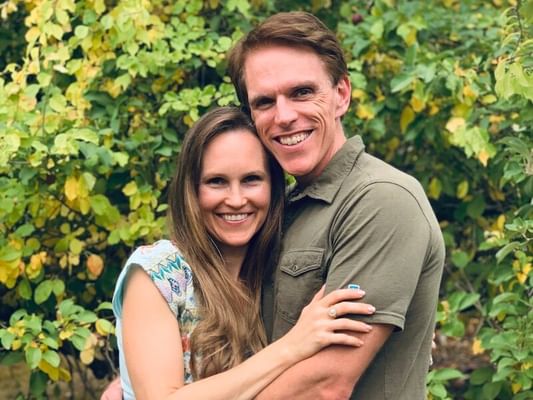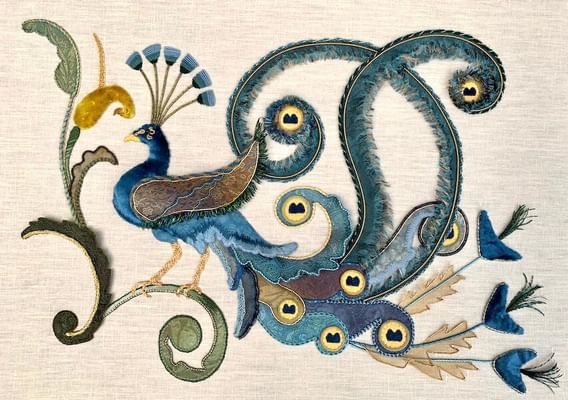- Undergraduate
Bachelor's Degrees
Bachelor of ArtsBachelor of EngineeringDual-Degree ProgramUndergraduate AdmissionsUndergraduate Experience
- Graduate
Graduate Experience
- Research
- Entrepreneurship
- Community
- About
-
Search
All Thayer News


Alumni Portrait: Kirsten Doogue Th'99 Th'00 & Mike Doogue Th'98
May 06, 2024 | by Betsy Vereckey
Electrical Engineers & Creatives
Kirsten and Mike Doogue began their careers together at Allegro MicroSystems, a Manchester-based semiconductor company, where Mike is currently senior vice president and chief technology officer. Kirsten went on to become an established embroidery artist who specializes in hand embroidery techniques. Today, they live in Bedford, NH, with their three children.

Kirsten & Mike Doogue.
The two met as engineering students in Thayer's Partner School Dual-Degree Program, which allowed them to earn a BA from their home institution and a BE from Dartmouth. Kirsten attended Wellesley and Thayer, majoring in chemistry, computer science, and electrical engineering before also earning her master's from Thayer, while Mike went to Colby and Thayer, earning degrees in physics and electrical engineering.
A shared mentor
At Thayer, both were fans of Professor William David Stratton for his ability to make complex electrical engineering topics approachable, digestible, and fun.
"He was a brilliant engineer who wanted us to work on making hard things simple," Mike said. "There were exams where he would say, 'If you need more than five lines of math to solve this problem, I'm going to take off one point for every extra line because you're making it too hard.'"
Kirsten was inspired by Professor Stratton's mantra that electrical engineering wasn't just something you learned in the classroom. "He made everything vibrant and taught us that you can do cool things with engineering and solve fun problems," she said. "He taught us that engineering doesn't just have to be a job. It can be everything and everywhere, in all parts of your life."
They both also appreciated Thayer's project-based classes for developing teamwork skills. "While I do think it's difficult to work through challenges related to group classes, it's an important part of learning and life," Kirsten said. "Group classes allow you to work with other people and constantly improve and learn to solve a problem where the answer isn't necessarily held by the teacher."
From engineering to embroidery
After graduating from Thayer, Kirsten worked in marketing at Allegro for approximately eight years, interfacing between Allegro's engineers and customers, and evaluating the feasibility of creating certain products.
"Thayer set me up beautifully for that job," she said. "I was the go-between for the engineers that were building semiconductors and the customers who knew they needed a particular chip but didn't know what the specs needed to be. One of the amazing things that Thayer does is create engineers who can communicate."
During evenings and weekends, Kirsten practiced hand-embroidery techniques, a hobby she began as a teenager when her mother taught her crewelwork, needlepoint, and cross-stitch. Like with engineering, she was drawn to the creative and detail-oriented aspects of the art.

Kirsten's peacock from 2018.
She eventually earned a diploma in technical hand embroidery from the Royal School of Needlework and took courses from the Embroiderers' Guild of America, which recognized her as a master craftsman in crewel embroidery in 2018. Currently, her focus is on Jacobean crewelwork, goldwork and silk stumpwork. She even visited the Victoria and Albert Museum for private viewings of their historic pieces to learn about stitch composition.
"What you discover when you look at these pieces is that people integrated different skills in a unique way that is not taught or broadly practiced today," she said. "Studying these historic pieces has allowed me to push my own creativity. You look at them and think, 'Oh my gosh, how did they do this?' and you start to do a kind of reverse engineering of the piece.'"
While Kirsten enjoyed her work in engineering, she soon discovered that she wanted to stay at home with her children. Even so, her degree gave her peace of mind that the option to go back was always there.
"When our second child came along, I decided my heart was more at home than it was at work, but it was important to me to have my engineering degree," she said. "I knew that even if I was out of work for a long time and wanted to go back into the workforce, people would know I was still capable of doing the job."
From chip designer to strategic thinker
Mike began working at Allegro right out of school as a chip designer. He loved how it gave him opportunities to create new product lines at a high level, interact with customers, and travel all over the world. Eventually, Mike started running Allegro's strategic marketing group, then various business units, and eventually became chief technical officer.
"It's been a super fun ride for me," he says. "Being in front of customers is what gives me energy. My job is to understand the problems our customers don't know how to solve yet, and then figure out how to bring them solutions in the next two to five years."
Mike is also responsible for creating the company's strategy, which involves mergers and acquisitions and bringing in new technologies. "I'm more focused on the longer-term view now, but there's still that pressure to go out and deliver in the short term as well."
Since Mike has been at Allegro, the company has hired more than 10 Thayer graduates. "Thayer cultivates independent-thinking, project-based engineers who are able to go out and make a splash in the world, and I love that," he said.
Encouraging the next generation
Two of their children are in high school and hoping to attend Thayer. Kirsten said the Dual-Degree Program is a great way to introduce students like her kids to engineering when they're not sure exactly what they want to do yet.
"It changed my life to have that opportunity,” Kirsten said. "Engineering sets you up to do a lot of different things. It teaches you how to look at the world and deconstruct what you see so that you can discover what you want to improve. Then you can drive improvements, in a different, creative way."
For contacts and other media information visit our Media Resources page.
